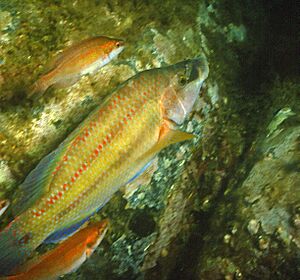East Atlantic peacock wrasse facts for kids
Quick facts for kids East Atlantic peacock wrasse |
|
|---|---|
 |
|
| Conservation status | |
| Scientific classification | |
| Synonyms | |
|
The East Atlantic peacock wrasse (Symphodus tinca) is a colorful fish found in the eastern Atlantic Ocean. You can also find it in the Mediterranean Sea and the Black Sea. This wrasse loves to live near rocks and in areas with eelgrass. It can even be found in slightly salty water, like in lagoons.
These fish usually live at depths from 1 to 50 meters (about 3 to 164 feet). While some can grow up to 44 centimeters (about 17 inches) long, most are around 25 centimeters (about 10 inches). People sometimes catch them for fun or for food. They are also sometimes kept in aquariums.
Contents
About the Peacock Wrasse
What Does It Look Like?
The East Atlantic peacock wrasse has a body that is flat and oval-shaped. Its mouth is quite small and can stick out a bit. It has strong, pointy teeth, like small canines. You might notice a few tiny holes on its snout and several folds on its lips.
Its head is usually longer than its body is deep. The fin on its back, called the dorsal fin, is very long and reaches almost to its tail. Both male and female wrasses have a small dark spot near the base of their tail fin. They also have a dark patch just above their pectoral fin (the fin behind their gills). Many darker spots on their body form three or four stripes running along their sides.
Colors of the Peacock Wrasse
The colors of the peacock wrasse are different for males and females. This is called sexual dimorphism. Females and young wrasses are usually grey-green or brownish. Their bellies are a silvery color. It can be hard to tell the difference between young males and adult females just by their color.
Male wrasses are much more brightly colored, especially when it's time to breed. They can be pale green, blue-green, or yellow-green. They often have rows of red spots along their sides. The top of their head can be a dark blue color.
How Big Do They Get?
East Atlantic peacock wrasses can grow up to 44 centimeters (about 17 inches) long. However, most of them are smaller, usually around 25 centimeters (about 10 inches).
What Do They Eat?
Peacock wrasses like to eat a variety of sea creatures. Their diet includes sea urchins, ophiuroids (like brittle stars), bivalves (like clams), shrimp, and crabs.
How Do They Reproduce?
Peacock wrasses lay their eggs in the spring. During this time, the male wrasse builds a nest out of seaweed. One or more females will then lay their sticky eggs in this nest. The male wrasse guards the nest to protect the eggs until they hatch.
Where Do They Live?
Peacock Wrasse Habitat
This fish is found in the eastern Atlantic Ocean, from Spain down to Morocco. It also lives in the coastal waters of the Mediterranean Sea and the Black Sea.
The East Atlantic peacock wrasse is a social fish that likes to live in groups. You can find them on rocky reefs covered with algae. They also live in sea-grass meadows and around rocks surrounded by eelgrass. Sometimes, they are found in slightly salty water, called brackish water, in lagoons. They live at depths ranging from 1 to 50 meters (about 3 to 164 feet) below the surface.
Fishing for Peacock Wrasse
Catching This Fish
The East Atlantic peacock wrasse is not a big commercial fish. This means it's not usually caught in large amounts by big fishing boats. However, local fishermen sometimes catch them using special nets called trammel nets.
For people who fish for fun, the peacock wrasse is often caught using a light fishing rod and reel. You can also catch them with a hand line or a small longline. They are not very picky about what they eat. They will often bite on small pieces of fish, prawns, paste, or even bread.
Larger peacock wrasse can sometimes be caught by people using a speargun.
Cooking Peacock Wrasse
Is It Good to Eat?
Many people don't realize how tasty the East Atlantic peacock wrasse can be. Its meat is soft, tender, and very flavorful. The only downside is that it's rare to find very large ones.
Smaller wrasse can be pan-fried. They are also a good addition to a mixed fish soup. If you catch a larger specimen, it can be cooked on a barbecue or used in a mixed fish stew.


